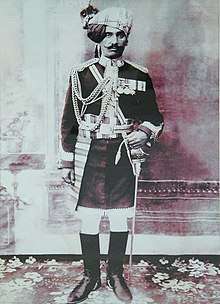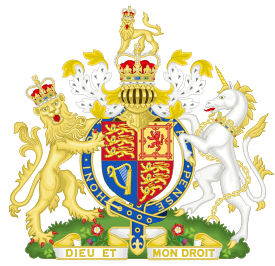Indian Distinguished Service Medal
The Indian Distinguished Service Medal (IDSM) was a military decoration awarded by the British Empire to Indian citizens serving in the Indian armed forces and police. When it was instituted in 1907 it was the second highest award available to Indians, behind the Indian Order of Merit, however, when eligibility for the Victoria Cross was extended to cover all Commonwealth subjects in 1911, the IDSM became third highest in the order of precedence. It was instituted in order to recognise acts of gallantry that did not meet the standards required of the IOM.[1] Following the Partition and subsequent independence of India in 1947, it was decided to discontinue the award.[2]
| Indian Distinguished Service Medal | |
|---|---|
Medal ribbon | |
| Awarded by British Empire | |
| Type | Military decoration |
| Eligibility | Indian citizens in the armed forces and police |
| Awarded for | Distinguished service |
| Status | Discontinued in 1947 |
| Description | Ribbon: blue and red ribbon Medal: round silver medallion |
| Clasps | No clasps |
| Post-nominals | IDSM |
| Statistics | |
| Established | 25 June 1907[2] |
| Total awarded | approx 6,000 including bars[1] |
| Order of Wear | |
| Next (higher) | King's African Rifles Distinguished Conduct Medal[3] |
| Next (lower) | Union of South Africa Queen's Medal for Bravery (Silver)[3] |
Upon being instituted the medal was only available to members of the British Indian Army, Indian State Forces, militias and levies, however, after 1917 it was extended to 'non-combatant' followers, such as carriers and grooms. In 1929 eligibility was extended to the Royal Indian Marine and to the Indian Air Force in 1940.[1]
There were four versions of the medal, the only difference being the monarch depicted on the obverse.[2] The medals were issued either with the engraved or impressed details of the recipient, including service number, name and regiment.[1]
The medal is considered reasonably rare and only about 6,000 were awarded, including bars. About 3,200 were awarded during the First World War, and 1,200 from the start of the Second World War to 1947. The remaining 1,600 were awarded between the wars during frontier fighting and other inter-war campaigns such as the Iraq campaign of 1919–20.[1]
Notable recipients
Honorary Captain and Subedar Major(Retired)U.M.Rai,IDSM,1944,3/10 Gorkha Rifles
- Risaldar Amir Singh Sudan, IDSM & Bar. 6th King Edward’s Own Cavalry.
- Havildar Puran Singh, MM, IDSM, 3/14th Punjab Regiment, British Indian Army (https://www.thegazette.co.uk/London/issue/36730/supplement/4572)
- Dafadar Mirza Muhammad Ali Beg, IDSM - France (20th Deccan Horse, ISDM)[4]
- Hon. Captain and Subedar (retd), Sardar Bahadur, Sant Singh Mangat, IOM, IDSM, OBI (1st Class, 1931), British Indian Army.[5]
- Colonel Rao Bahadur Thakur Balu Singh ji Inderpura, OBI,IDSM (1st Class)
 Col Rao Bahadur Balu Singh OBI IDSM
Col Rao Bahadur Balu Singh OBI IDSM - Jemadar Abdul Latif Khan Tarin, IDSM, 82nd Punjabis, British Indian Army.[6][7]
- Khan Saheb Subedar Allauddin, IDSM, 1915/16, served in 99 Hyderabad Regiment
- Subedar Mir Afzal Khan, IDSM, 25th Punjabis, British Indian Army.[8]
- Subedar Ahmed Khan, OBI, IDSM, Queen Victoria's Own Corps of Guides, British Indian Army.[9]
- Jemadar Ram Singh, IDSM, 25th Mountain Battery, British Indian Army.[10]
- Subedar Shah Zaman Khan, IDSM, QVO Corps of Guides, British Indian Army.[11]
- Naik Balwant Singh, IDSM, The Sikh Regiment, British Indian Army.[12]
- Risaldar Rawat Singh Mertiya, IDSM Sindarli (34th Prince Albert Victor's Own Poona Horse, IDSM, France)[13]
- Sardar Bahadur Risaldar Major Chander Singh Rathore, IDSM, of Dhingsara&Bajekan (Jodhpur Risala) 1921, later served as A.D.C to King George Vth.
- Subedar Kifayat Ullah, IDSM 1918 (32nd Mountain Battery British India Army)
- Risaldar-Major Muhammad Ashraf Khan, IOM, IDSM, RIASC, Force K6. Received the IDSM in the Tribal Areas of NWFP in 1935 and the IOM for the Dunkirk evacuation in 1940.[14]
- Subadar Major Attar Singh, OBI, IDSM, Bahadur [35th Sikhs, 2nd Battalion], 1920[15], British Indian Army
- Kot Dafadar Kapur Singh IDSM, 30th Lancers. World War 1 [16]
Notes
- Duckers 2001, pp. 40–41.
- Robertson, Megan. "Medals of the United Kingdom". Medals of the World. Medals.org. Retrieved 27 May 2009.
- "No. 56878". The London Gazette (Supplement). 17 March 2003. p. 3352.
- http://glosters.tripod.com/ICawards1.htm
- London Gazette, Monday, 10 April 1911
- S Najumddin, List of Some Better-Known IDSM Recipients British Indian Army during World War 1, in Durbar Journal of the Indian Military Historical Society UK, No 3, Autumn 2011
- Also see record in the Commonwealth War Graves Commission database at http://www.cwgc.org
- Durbar List 2011 a.a.
- Durbar List 2011,a.a.
- Durbar List 2011
- Indian Army List (IAL)1925
- Durbar List 2011 aa
- http://glosters.trkhcom/ICawards1.htm
- http://www.brownpundits.com/2016/10/25/film-royal-indian-army-service-corps-in/ Brown Pundits site giving details of Force K6 in WW2. Retrieved 30/3/2018
- https://www.thegazette.co.uk/London/issue/32131/supplement/11317/data.htm
- London Gazette 26th June 1916
References
- Duckers, Peter (2001). British Gallantry Awards, 1855–2000. London: Osprey Publishing. ISBN 978-0-7478-0516-8.
External links
- "Indian Distinguished Service Medal, 1943, awarded to Naik Shamsher Singh, 2nd Battalion, 1st Punjab Regiment". National Army Museum. Retrieved 10 November 2016.
- "No. 28034". The London Gazette (Supplement). 25 June 1907. p. 4429.
